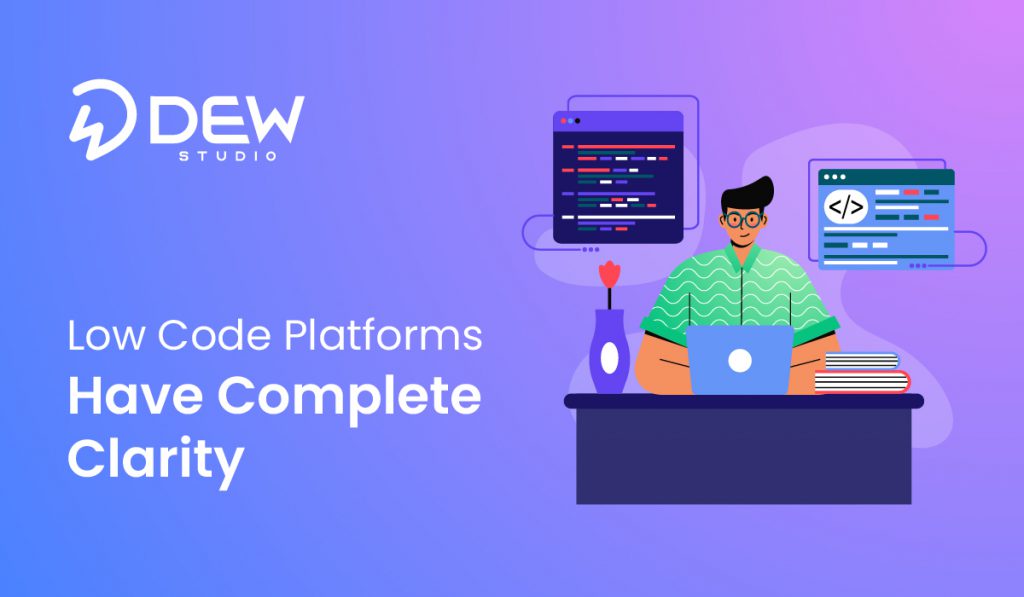
Have you ever wondered how businesses can roll out new apps and digital products so quickly?
The credit can lead to the rise of low-code development platforms. Over the past few years, low code has surged in popularity, revolutionizing the software industry. This approach enables businesses to create fully functional applications at an unprecedented speed. Consequently, businesses gain a competitive edge over their competitors and also effortlessly drive digital transformation.
Low code development allows for rapidly building applications with minimal complex coding. Whether it’s SaaS products, websites, or mobile apps, these solutions are crafted using third-party toolkits that prioritize visual development.
These toolkits streamline the process from concept to design to commercialization by utilising graphical drag-and-drop interfaces. Stay tuned as we delve into the impressive statistics highlighting the impact and growth of low-code in the tech industry.
Few Facts on Low Code
Termed in the year 2014 by analyst firm Forrester.
By 2017, Forbes called low code development “extraordinarily disruptive,” meaning it was dramatically changing the industry.
Over the past year, low code has grown rapidly. The pandemic has pushed organizations to speed up their digital transformation, and IT departments are under more pressure to provide value to businesses and their users.
So, how does low code impact the software industry? Gartner projects that investments in low code development platforms will yield $31.9 billion in revenue in 2024.
Future of Low Code Platform
Low code methods heavily influence the future of web development. Gartner predicts that by 2024, more than 65% of application development will be done using low-code.
Low code tools are designed for people without a technical coding background, known as citizen developers. Putting up the reference of TecRepublic website, it is assumed that approximately 60% of all custom apps are now built outside of the IT department, and 30% of those are created by employees with little to no technical skills. These tools help organizations reduce their backlog, cut costs, improve flexibility, and create automated solutions easily.
Insight on Types of Low Code Platforms
The types of low-code platforms are categorized into five main categories, creating a low-code working model.
General-Purpose Platforms
- Designed for a wide range of applications.
- Suitable for various industries and use cases.
- Examples: OutSystems, Mendix.
Process Automation Platforms
- Focus on automating business processes.
- Help streamline workflows and improve efficiency.
- Examples: Appian, Pega.
Database-Oriented Platforms
- Centered around database management and operations.
- Ideal for applications that require extensive data handling.
- Examples: Knack, Airtable.
Mobile-First Platforms
- Specialize in developing mobile applications.
- Provide tools for building responsive and native mobile apps.
- Examples: Appgyver, Thunkable.
Enterprise-Grade Platforms
- Built for large-scale, complex enterprise applications.
- Offer advanced security, scalability, and integration capabilities.
- Examples: Salesforce Lightning, Microsoft PowerApps.
Integration Platforms
- Focus on integrating various systems and applications.
- Facilitate data flow and connectivity between different software.
- Examples: Boomi, Zapier.
E-commerce Platforms
- Tailored for creating and managing online stores.
- Provide features like inventory management, payment gateways, and product catalogs.
- Examples: Shopify, BigCommerce.
Niche-Specific Platforms
- Designed for specific industries or specialized use cases.
- Offer customized solutions tailored to unique business needs.
- Examples: Quick Base (construction) and Caspio (healthcare).
Use Case of Low Code
It is now clear that low code technology does not require experienced developers. For creating websites, apps, and user interfaces, low-code technology lifts the technical barrier. The solution is offering drag-and-drop interfaces which allows anyone, even without coding skills, to build and customize sites for multiple devices from one platform.
Examples of low-code tools include Wix or WordPress. They all have drag-and-drop features for creating customizable websites or user interfaces.
Besides websites and apps, low-code tools help marketers quickly build and design email campaigns and ads using drag-and-drop functions. A good example is MailChimp, which has an easy-to-use email builder.
Application Features of Low-Code Development
Low-code development platforms offer popular features that enable rapid creation of custom apps and integrations. These features include:
- Drag-and-Drop Interfaces
- Pre-Built Templates
- Automation Tools
- Integrations
- Scalability
- User-Friendly Dashboards
These features help businesses quickly develop and deploy custom solutions.
Low Code Solution, Development & Developers
Low code and citizen developers are becoming very popular, especially since the pandemic. Businesses need to adapt quickly, and low code helps them create new digital solutions quickly, giving them an edge over competitors. Forbes mentions that companies can’t afford to take years to organize their IT departments, and low-code offers a proven way to quickly develop new solutions.
Such tools are leading to more citizen developers—people who can build apps without great technical skills. Predictions from 2021 highlighted that low-code would lead to the creation of new roles in companies, like automation architects or citizen developers, who can efficiently handle automation and integration tasks.
Web developers are still important, but now almost anyone can design and create web apps, mobile apps, and integration workflows using low-code tools. The benefits of low code include faster time to market, better digital transformation, lower costs, increased productivity and agility, improved customer experience, and quicker app development.
Conclusion
DEWStudio, developed by the TechRev LLC team, exemplifies the power and potential of low code app development platforms. By offering intuitive drag-and-drop interfaces, pre-built templates, and robust integration capabilities,
DEWStudio empowers businesses to rapidly develop custom applications and streamline their digital transformation efforts. This platform not only accelerates time to market but also reduces development costs, enhances productivity, and improves overall agility. As the demand for efficient and user-friendly development solutions grows, DEWStudio stands out as a premier choice for organizations looking to stay competitive and innovative in the ever-evolving tech landscape.


